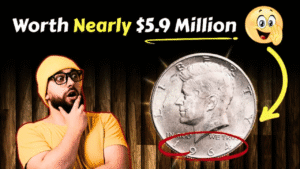Picture this: you’re fishing through your change for a quarter, and one catches your eye—a 1976 Bicentennial Quarter with its iconic drummer boy design. Most of these coins are worth just 25 cents, but a rare few could make you a fortune. Some have sold for thousands, and one legendary version reportedly fetched $1 million at auction.
Could you have one hiding in your pocket or coin jar? Let’s dive into what makes these quarters so special and how to spot a valuable one.
Why the Bicentennial Quarter Is Unique
Minted in 1975 and 1976 to celebrate America’s 200th anniversary, the Bicentennial Quarter features a dual date (1776-1976) and a drummer boy on the reverse. It’s a nostalgic piece of history, but what makes some of these coins valuable isn’t their age—it’s their rarity and condition.
What Makes a Bicentennial Quarter Worth Millions?
Certain Bicentennial Quarters stand out due to minting errors or special editions. Here are the key types to look for:
1976-S Silver Proof Quarter
The U.S. Mint produced a limited run of 40% silver proof quarters for collectors, struck at the San Francisco Mint with an “S” mintmark. In pristine, uncirculated condition, these can sell for $10 to $5,000, depending on their grade. Their silver content alone adds intrinsic value.
The Rare “No S” Proof Quarter
The holy grail is the “No S” Proof Quarter. A tiny batch of silver proof quarters left the San Francisco Mint without the “S” mintmark—a rare mistake. Only a handful are known to exist, and one reportedly sold for over $1 million in 2019. This error makes it a legend among collectors.
Other Minting Errors
Quarters with double-die errors (where text or images appear doubled) or off-center strikes can also fetch hundreds or thousands. These mistakes are rare but add significant value.
| Feature | Description | Potential Value |
|---|---|---|
| Silver Proof | 40% silver, “S” mintmark, pristine condition | $10 – $5,000 |
| “No S” Proof | No “S” mintmark, extremely rare | Up to $1 million+ |
| Double-Die Error | Doubling on text or design | $50 – $1,000+ |
| Off-Center Strike | Misaligned design | $20 – $500+ |
Where Could You Find a Rare Quarter?
Bicentennial Quarters are still common in circulation—think coin rolls, cash registers, or old jars at home. While the ultra-rare “No S” Proof Quarters were meant for collectors and rarely circulate, silver proofs and error coins occasionally pop up in unexpected places like estate sales, flea markets, or inherited collections.
The thrill of the hunt keeps collectors hooked. Even if a million-dollar coin is a long shot, finding a silver proof or minor error could still net you a tidy sum.
How to Spot a Valuable Bicentennial Quarter
Think you’ve got a keeper? Here’s how to check:
- Inspect the Mintmark: Look below the date on the front. An “S” indicates a San Francisco proof; no “S” on a proof coin is a rare find.
- Check for Silver: Silver proofs have a shinier look and weigh slightly more (about 6.3 grams vs. 5.7 grams for copper-nickel). A coin dealer can confirm.
- Look for Errors: Use a magnifying glass to spot doubled text or misaligned designs.
- Don’t Clean It: Cleaning a coin can ruin its value. Collectors want original condition, even if it’s tarnished.
- Get It Graded: If it seems special, have it appraised by PCGS or NGC for authenticity and value.
Pro Tip: Store coins in protective sleeves to avoid scratches or damage.
Selling Your Rare Find Safely
Found a gem? Stick to reputable channels to sell it. Auction houses like Heritage Auctions or Stack’s Bowers specialize in rare coins and attract serious buyers. For smaller sales, trusted coin dealers or platforms like eBay work, but beware of scams—always verify authenticity first.
Why the Hunt Is Worth Your Time
Even if you don’t find a $1 million quarter, the search is exciting. Bicentennial Quarters are a piece of American history, and finding a silver proof or error coin can still bring in hundreds or thousands. With the 50th anniversary of the Bicentennial nearing in 2026, interest in these coins is skyrocketing.
Next time you get change, check for that drummer boy. You might just hold a ticket to a small fortune—or at least a great story.
FAQ: Your Questions About Bicentennial Quarters Answered
Q: What makes a 1976 Bicentennial Quarter valuable?
A: Rarity, like the “No S” Proof or double-die errors, and pristine condition drive value. Silver proofs also carry a premium.
Q: How do I spot a “No S” Proof Quarter?
A: Check for no “S” mintmark below the date on a shiny, proof-quality coin. These are extremely rare and likely not in circulation.
Q: Are all Bicentennial Quarters worth a lot?
A: No, most are worth 25 cents. Only silver proofs, error coins, or the rare “No S” Proof fetch high prices.
Q: Where can I sell a valuable quarter?
A: Use auction houses like Heritage or Stack’s Bowers, or consult a trusted coin dealer after grading by PCGS or NGC.
Q: Can I find these quarters in circulation?
A: Yes, silver proofs and minor error coins can appear in change, coin rolls, or old collections, though “No S” Proofs are unlikely.




